Bengal cat: features of the breed and character
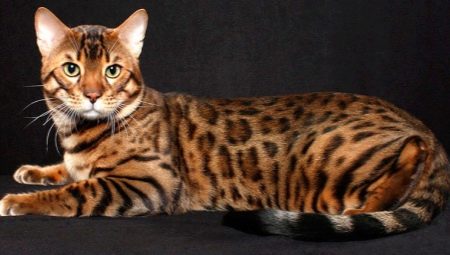
Before purchasing a purebred pet, it is advisable to study all the nuances that you have to face. Bengal cats are a young and relatively little-known breed that is rapidly gaining popularity. Therefore, it is worth considering the main features of Bengal cats and finding out what character the representatives of this breed differ in.
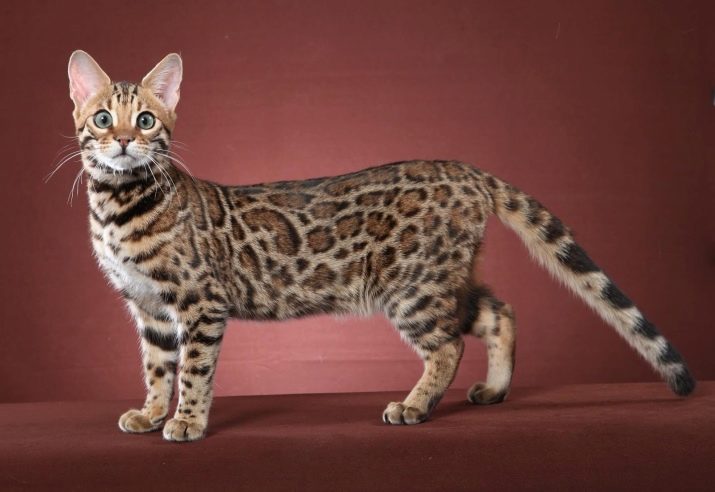
Description of the breed
The "mother" of this unique breed is the American geneticist Jig Sugden, who, during a trip to South Asia in 1961, acquired a wild Bengal cat and took it home. Only in 1982 did she manage to get stable hybrids of a wild Asian cat with a domestic one.
Well, the official year of birth of Bengals is considered to be 1991, when the international standard for cats of this breed was approved, which combines the color and swiftness of wild leopards with the complaisance of ordinary domestic cats. According to this standard, an adult (over 2 years old) Bengal cat has the following characteristics:
- the body weight of these animals usually ranges from 5 to 6 kg;
- the height of Bengals at the withers varies between 25 and 32 cm;
- the life expectancy of such a pet will be from 12 to 15 years;
- the body of these animals should be muscular and stretched;
- the length of the hind legs of Bengals should be longer than that of the front;
- the neck should be long and thick;
- the head has small dimensions relative to the body, wedge-shaped and differs in rounded contours;
- eyes should be deep green or golden in color (for colorpoints, blue is allowed) and have an oval shape;
- the nose of these cats is quite wide;
- the ears should be at the edges of the head and be relatively short in length, widened towards the base, and also have rounded tips;
- the cheeks of this breed are relatively plump, and the sets are quite massive.

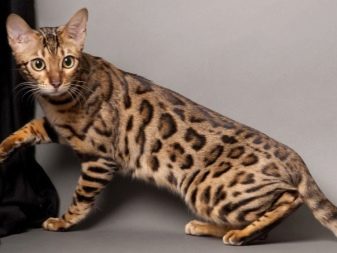
One of the important signs is the color, in which the main tone is usually different shades of brown. There are also Bengals, whose color is dominated by snow, blue, coal and even silvery tones. Regardless of the base color, all Bengals must have a pattern, which can be:
- marble;
- spotted (a la leopard);
- rosette (spots with a darker edging).
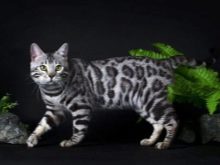
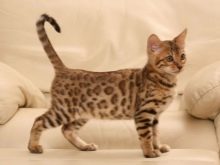
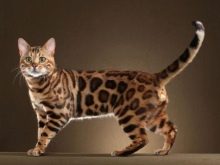
The color of the picture is usually black, gray or brown, while the picture is always darker than the main tone. Any white spots on the coat are considered a defect, such kittens from professional breeders must be discarded. The tail color can be spotted or ringed, and the tip of the tail must be dark. Regardless of the color option, all cats of this breed are distinguished by the presence of thick, soft and shiny coat.
The length of the coat varies between short and medium. Finally, the voice of Bengals differs from most classical breeds - it is noticeably louder, it has much more sonic shades.
Character and behavior
Despite the fact that there are many truly wild cats among the ancestors of this breed, it would be simply impossible to keep them at home, a purebred Bengal is distinguished by an affectionate and playful character, as well as a very developed intellect. Moreover, if in other breeds only kittens are active and playful, then Bengals retain this character trait throughout their life. Thanks to this, these cats get along very well with children and other animals.
Such habits require that the pet is always provided with toys and the attention of the owners. In such conditions, Bengals "bloom" and even begin to behave a little like dogs - they can come running at the call of the owner, bring him their toys.
The love of activity and play also has a downside - a Bengal growing in an aviary will grow fearful and may even show unmotivated aggression. And if your pet thinks that you are paying little attention to him, he may deliberately start stealing small objects. Finally, in the absence of cat toys, things that are needed in the household can become the subject of the Bengali's games.
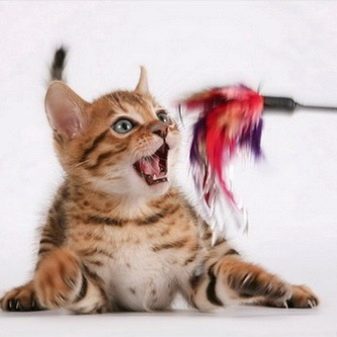
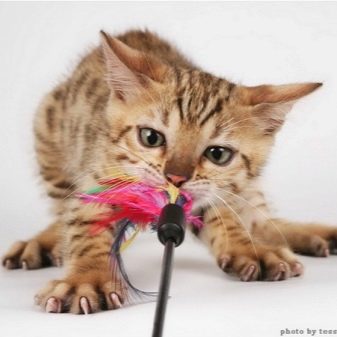
These cats are completely devoted to the owner and gladly accept other members of his family, other cats, dogs and even guests. Of course, it's not worth stroking a Bengali right away when you come to visit his owners, but after a few minutes of acquaintance he will happily play with you. It should be borne in mind that playfulness in all cats is a continuation of hunting instincts, therefore Bengalis are equally active “playing” with ordinary toys and with live mice, birds and other small animals.
But the end of such games is usually the death of a "living toy", so the cages with parrots and domestic rodents in the house where the Bengal cat lives should always be closed. An interesting feature of the character of these pets can be called an atypical love for water for felines. Bengals are very fond of playing with water running from an open tap, and some representatives of the breed can even happily take a bath.
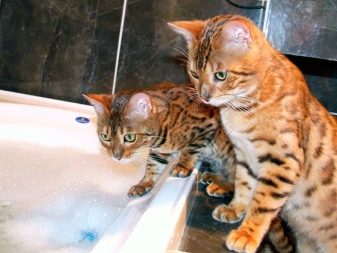
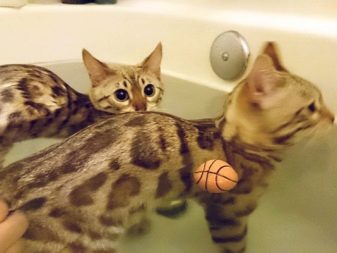
Advantages and disadvantages
The main, from the point of view of breeders, the advantages of cats of this breed over others:
- "Leopard" color, expressive eyes, sharp body contours (in the exterior of Bengals, everything speaks of their wild blood), so this breed is ideal for lovers of exotic and simply beautiful cats;
- due to its sociability, this breed is a good choice for families where there is already a child or other pets;
- despite the origin, they are generally distinguished by an agreeable character and a developed mind, which allows even a little training of such cats;
- the character of these cats is distinguished by devotion, playfulness and love of communication;
- like all hybrids, they are in fairly good health and rarely get sick;
- most of these cats have short hair, making it easy to care for;
- Bengal wool is practically hypoallergenic;
- these pets are very clean and love water;
- Bengals can be walked on the street.
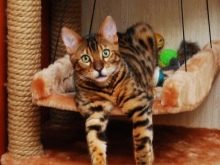
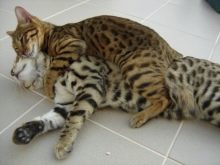
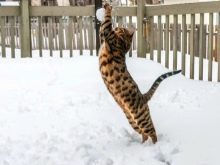
This breed also has a number of disadvantages:
- ancestors of Bengals led a very active lifestyle, so their health suffers without regular physical activity (you may even need to purchase "simulators");
- if, in response to loyalty and playfulness, the cat does not receive enough attention, aggression may wake up in it;
- love for water, combined with a lively inquiring mind, can result in the pet learning to independently open the taps and drain the water in the toilet, which can create a number of inconveniences for the owners;
- it is impossible to walk Bengals without a leash - wild blood can make an animal escape at any moment;
- These cats do not like to sit in the owner's arms for a long time - the love of freedom and activity takes precedence over devotion;
- non-castrated males have a habit of marking furniture;
- the loud and rich voice of this breed can wake anyone up.
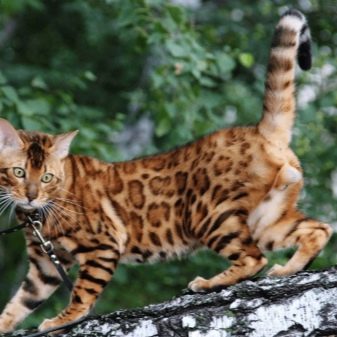
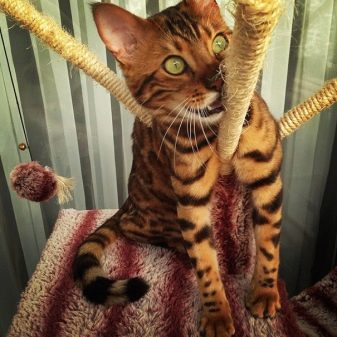
Owner reviews
Most of the owners of these cats are very pleased with their appearance and character. Also, many owners are pleased that this breed almost does not shed and does not leave hair throughout the apartment. Most of all criticism is sometimes caused by excessive playfulness, which, with a lack of attention, develops into mischief. Also, not all cat lovers are ready to endure the loud voice of cats and cats of this breed in the spring or when they want to eat.
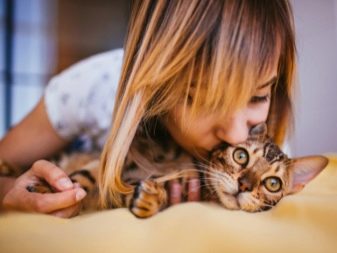
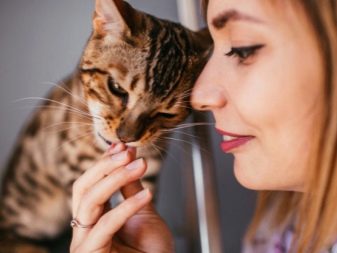
For the characteristics of the breed, see below.

































We took a Bengal cat at the age of two months. It grows quickly - in a month plus a pound. Beautiful but overly active. She runs around the apartment, rolls on the curtains (I had to take it off), got out the second cat (British) - fearless, loves water - she always helps to wash the dishes, floors, throws her bowl of water. I highly do not recommend a small kitten for a family with children - they can scratch and bite. And it's better not to take them to a small apartment - this breed needs space.
I have a silver Bengal cat named Leonardo.
I want to have a cat, I can't decide on the choice of breed, I am considering a Bengal, is it true that they can write on the bed?
Oksana, never. They are very neat, with character, smart, fearless and very active.
Oksana, however, especially when she asks for food. It is necessary to follow and immediately transplant into the tray. Can be weaned.
Everyone can do it))))
Take a Bengal, you will not regret it: very beautiful, kind, smart cats. Our cat is very talkative))) We took him at 2 months, there was a case: he wrote to us on the bed early in the morning, when we were still asleep, in the first two days, then only to his tray. Now he is already a year old, and he has never played a dirty trick.